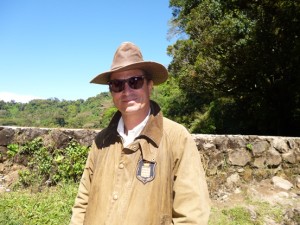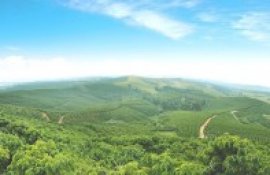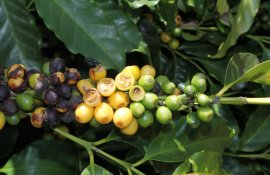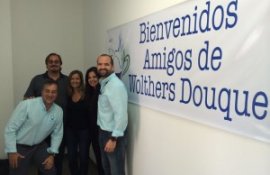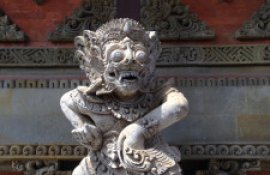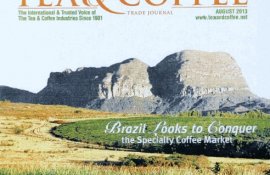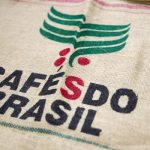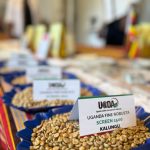MonteCarlos Estate – A Volcano Turned into a Coffee Estate
It has taken me more than a couple of years to take up Carlos Batres and his wife Julie on an invite to visit them at the MonteCarlos Estate located in Central El Salvador.The reason behind my delay to visit is unknown but I always promised to visit as soon as I came to their country. In fact, this was my first time in their beautiful El Salvador.
I wrote to Carlos a week before my arrival and told him that I would drive in from Guatemala and have a couple of days to stop at the beaches in Sunzal.
The drive from Guatemala into El Salvador was like a small adventure as the coastal road is not in the best condition after torrential rains in October and November. Bridges were down, many stretches had no asphalt and the boarder customs were on strike. It took me and my crew 8 hours through the darkness to wobble by stranded cargo trucks, angry truck drivers and unwilling boarder police to finally get into El Salvador by midnight on December 1st.
When Don Carlos came to pick me up, I was very relaxed and had enjoyed a great time at the beaches. Driving inland and escalating from sea level to the foot of the La Nimfa Volcano at 4500′ was exciting. The journey from sea level to the top of the volcano where the Batres have their farm house was breathtaking.
The farm house stands at the very top western rim of the volcano. It faces the El Salvador Valley which looks all the way into Guatemala. To the east is Honduras, to the West, the Valley and the Pacific Ocean and to the South, the volcano crater and lake with the Great Pacific in the distance. The house was built entirely with cooked lava rock from the Estates geysers. I will refer to the house as “The Rock” from now on.
As we arrived at the Rock, Carlos hurried to prepare the ATV’s for a sunset ride down the West Wall of the Volcano. The Estate is formed by 4 variatles planted at different altitudes down the whole volcano wall and spreading to the flat lands at its foot. The plantations are formed by blocks that work as wind breakers all the way down the volcano and a network of ATV trails connect the whole farm. We made it halfway down before darkness came and we had to return back up the narrow trails to the Rock for a delicious dinner and rest.
The winds were constant all night and the temperature was quite low as it reached the 50’s. I could then relate to the necessity of planting within wind breaking green walls protecting the coffee trees and fruits.
Next morning! After a hot cup of Pacamara Coffee, eggs, croissants and OJ, it was time to leave on the ATV’s to visit the entire farm. On the way down the North side of the Volcano Wall, Don Carlos picked up his farm Manager for the weekly plantation inspection. We drove through the Pacamara, Bourbon, Catuai and finally, on the lower side, the new Caturra.
Don Carlos at the Sun Drying Patios[/caption]The drive took 4 hours and we covered all the faces of the volcano and its plantations. We visited the La Nimfa Crater with its lake and cloud forest around the inner wall, the geysers at mid altitude and the North Valley.eATV tour ended at the benefio and drying Patio located at the Southeastern lower lands of the farm. There lies the original old farmhouse where Don Carlos and his family enjoy the memories and history that date back to his great Grandparents!
The receiving station, the pulpers and the fermentation tanks were pristine in concept and care. Furthermore, Don Carlos has his own little secret in preparation as he washes all coffees three times. The drying patios are also outstanding in their design.
They provide the most efficient 100% sun dried coffee as the whole structure works by gravity inclination and is setup to get maximum sunlight exposure.
The patios are being expanded to address the expected productivity increase and as in the best processing practices.
Don Carlos uses specially designed and built clay tiles for ultimate temperature absorption and parchment integrity. Just under the patio, is the home of 400,000 young coffee plants at the Estate’s nursery.
There, current and new viriatles will provide for the plantation renewal as well as to populate new areas already planned.
While El Salvador has seen its coffee plantations and quality decline dramatically in the past 10 years, here at the MonteCarlos Estate the direction is opposite! This farm is certainly one of the most beautiful properties I have seen out of the thousands of coffee farms I visited.
Carlos and Julie Batres are an example of how to farm coffee, produce outstanding quality and succeed against adversity and difficulties when they arise.
The MonteCarlos Estate, Carlos and Julie Batres exist !!!
If you want to contact the Monte Carlos Estate, please send an email to montecarlos@integra.com.sv Phone – (503) 2263-4044
by Christian B. Wolthers
Category: Archives

